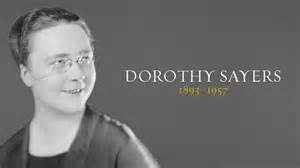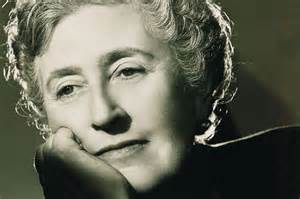TODAY IN LITERARY HISTORY: Birthday of Dorothy Sayers
Dorothy Leigh Sayers (13 June 1893 – 1957) was a renowned English crime writer, poet, playwright, essayist, translator, and Christian humanist. She was also a student of classical and modern languages.
She is best known for her mysteries, a series of novels and short stories set between the First and Second World Wars that feature English aristocrat and amateur sleuth Lord Peter Wimsey, which remain popular to this day.
However, Sayers herself considered her translation of Dante's Divine Comedy to be her best work. She is also known for her plays, literary criticism, and essays.
Sayers' longest employment was from 1922 to 1931 as a copywriter at S.H. Benson's advertising agency, located at International Buildings, Kingsway, London. Sayers was quite successful as an advertiser. Her collaboration with artist John Gilroy resulted in "The Mustard Club" for Colman's Mustard and the Guinness "Zoo" advertisements, variations of which still appear today. One famous example was the Toucan, his bill arching under a glass of Guinness, with Sayers's jingle:
 Sayers is also credited with coining the slogan "It pays to advertise!" She used the advertising industry as the setting of Murder Must Advertise, where she describes the role of truth in advertising:
Sayers is also credited with coining the slogan "It pays to advertise!" She used the advertising industry as the setting of Murder Must Advertise, where she describes the role of truth in advertising:... the firm of Pym's Publicity, Ltd., Advertising Agents ...
"Now, Mr. Pym is a man of rigid morality—except, of course, as regards his profession, whose essence is to tell plausible lies for money—"
"How about truth in advertising?"
"Of course, there is some truth in advertising. There's yeast in bread, but you can't make bread with yeast alone. Truth in advertising ... is like leaven, which a woman hid in three measures of meal. It provides a suitable quantity of gas, with which to blow out a mass of crude misrepresentation into a form that the public can swallow."
Detective Fiction
Sayers began working out the plot of her first novel some time in 1920–21. The seeds of the plot for Whose Body? can be seen in a letter that Sayers wrote on 22 January 1921:
My detective story begins brightly, with a fat lady found dead in her bath with nothing on but her pince-nez. Now why did she wear pince-nez in her bath? If you can guess, you will be in a position to lay hands upon the murderer, but he's a very cool and cunning fellow ... (p. 101, Reynolds)
Sayers did not content herself with writing pure detective stories; she explored the difficulties of First World War veterans in The Unpleasantness at the Bellona Club, discussed the ethics of advertising in Murder Must Advertise, and advocated women's education (then a controversial subject) and role in society in Gaudy Night.
In Gaudy Night, Miss Barton writes a book attacking the Nazi doctrine of Kinder, Kirche, Küche, which restricted women's roles to family activities, and in many ways the whole of Gaudy Night can be read as an attack on Nazi social doctrine. The book has been described as "the first feminist mystery novel."
Sayers's Christian and academic interests are also apparent in her detective series. In The Nine Tailors, one of her most well-known detective novels, the plot unfolds largely in and around an old church dating back to the Middle Ages. Change ringing of bells also forms an important part of the novel. In Have His Carcase, the Playfair cipher and the principles of cryptanalysis are explained. Her short story Absolutely Elsewhere refers to the fact that (in the language of modern physics) the only perfect alibi for a crime is to be outside its light cone, while The Fascinating Problem of Uncle Meleager's Will contains a literary crossword puzzle.Lord Peter Wimsey burst upon the world of detective fiction with an explosive "Oh, damn!" and continued to engage readers in eleven novels and two sets of short stories, the final novel ending with a very different "Oh, damn!". Sayers once commented that Lord Peter was a mixture of Fred Astaire and Bertie Wooster, which is most evident in the first five novels. However, it is evident through Lord Peter's development as a rounded character that he existed in Sayers's mind as a living, breathing, fully human being.
Sayers introduced the character of detective novelist Harriet Vane in Strong Poison. She remarked more than once that she had developed the "husky voiced, dark-eyed" Harriet to put an end to Lord Peter via matrimony. But in the course of writing Gaudy Night, Sayers imbued Lord Peter and Harriet with so much life that she was never able, as she put it, to "see Lord Peter exit the stage".
Sayers began working out the plot of her first novel some time in 1920–21.
Sayers also wrote a number of short stories about Montague Egg, a wine salesman who solves mysteries.
Sayers was a founder and early president of the Detection Club, an eclectic group of practitioners of the art of the detective novel in the so-called golden age, for whom she constructed an idiosyncratic induction ritual.
The Club still exists, and, according to the late P.D. James who was a long-standing member, still uses the ritual. In Sayers' day it was the custom of the members to publish collaborative detective novels, usually writing one chapter each without prior consultation. These works have not held the market, and have only rarely been in print since their first publication.
Get a Daily Dose of Literary History: Like and Follow Blind Horse Books.
Building Great Collections, One Fine Book at a Time
Visit us at BlindHorseBooks.com






Comments
Post a Comment